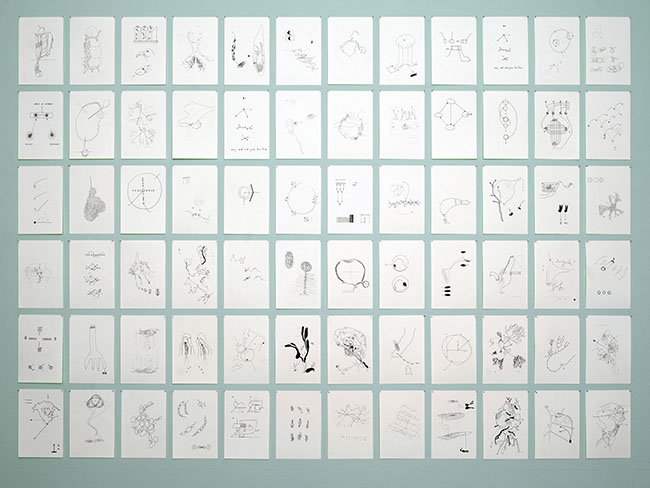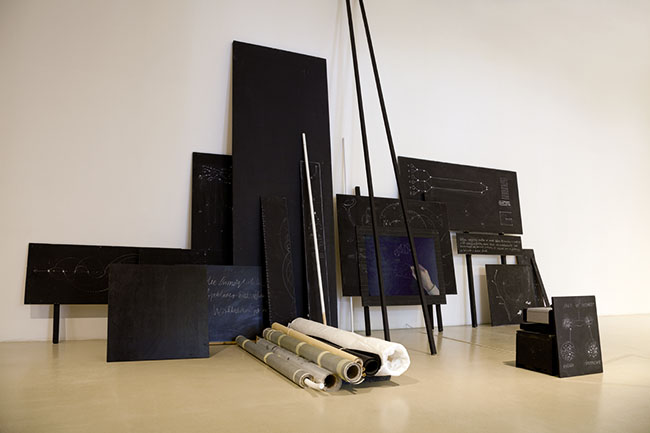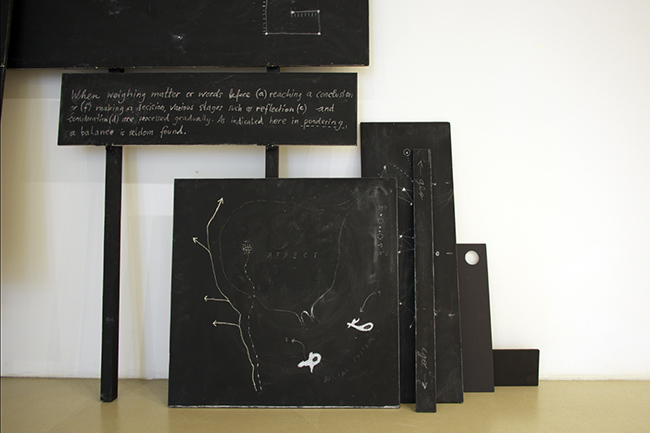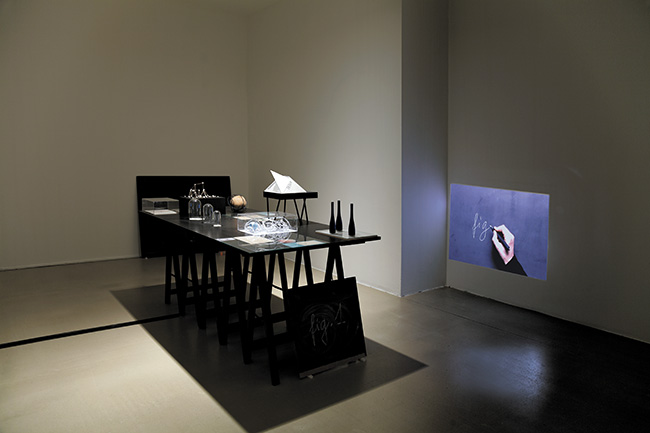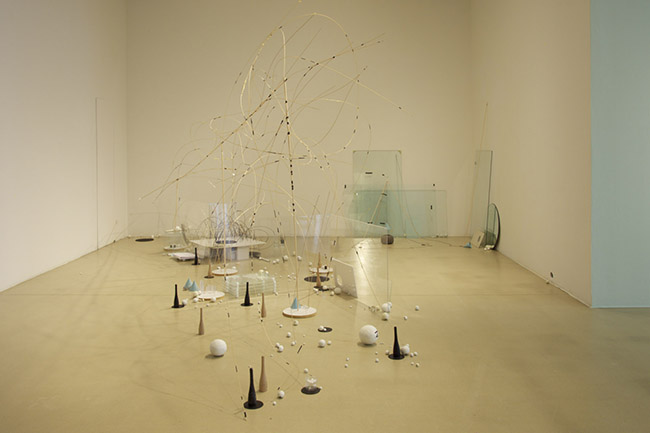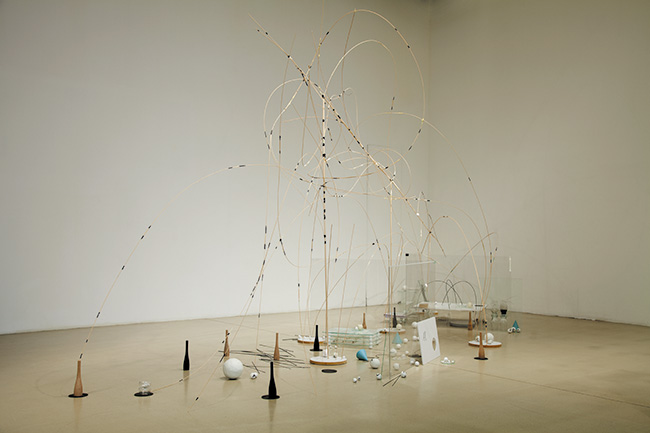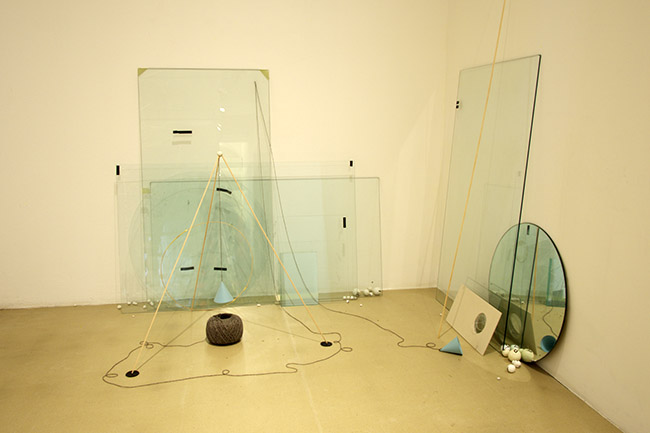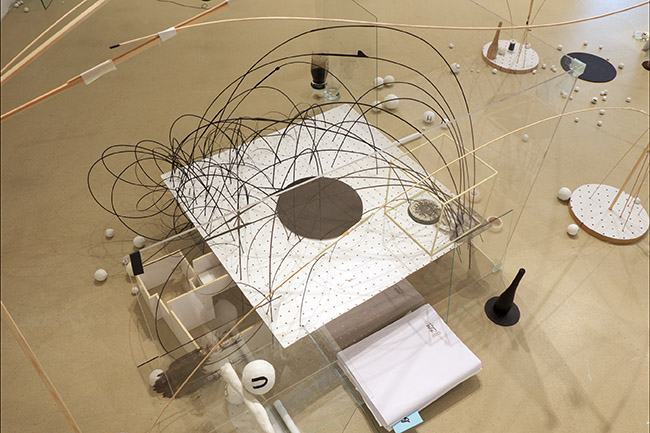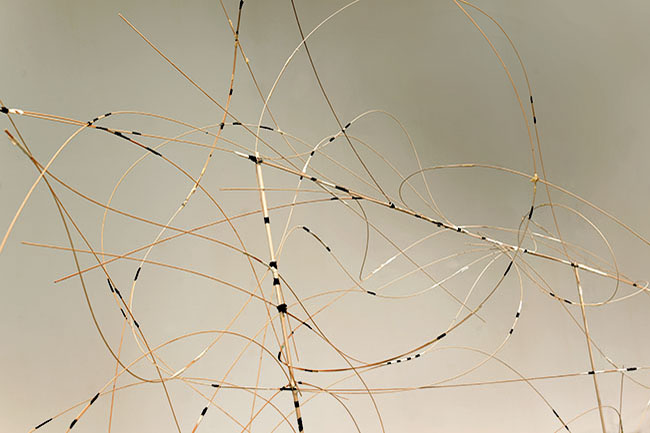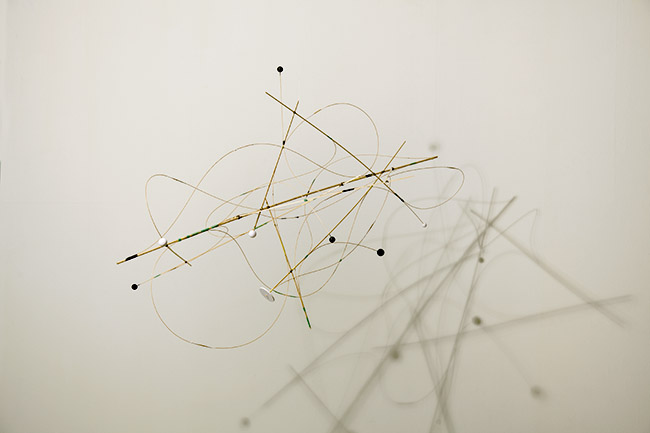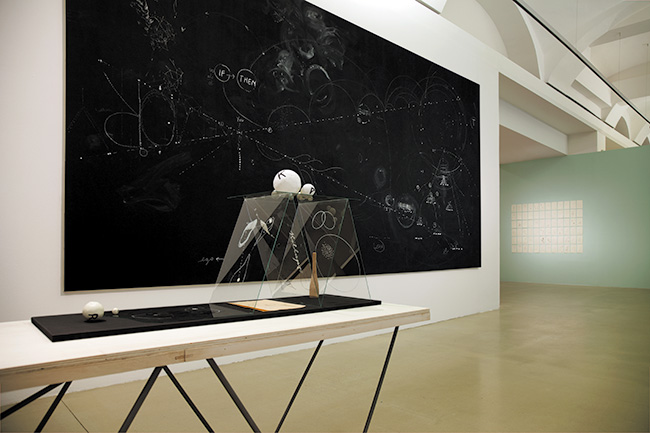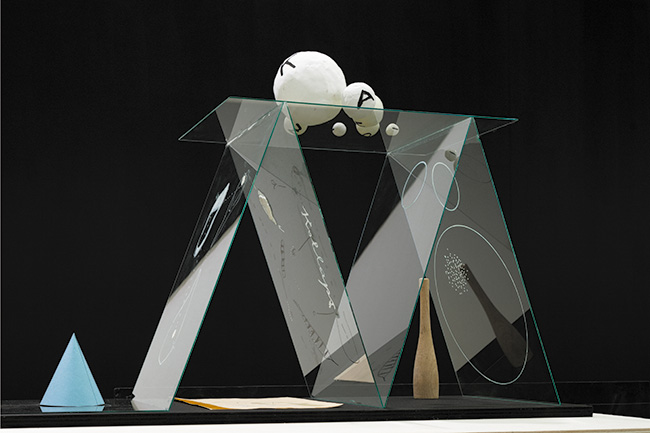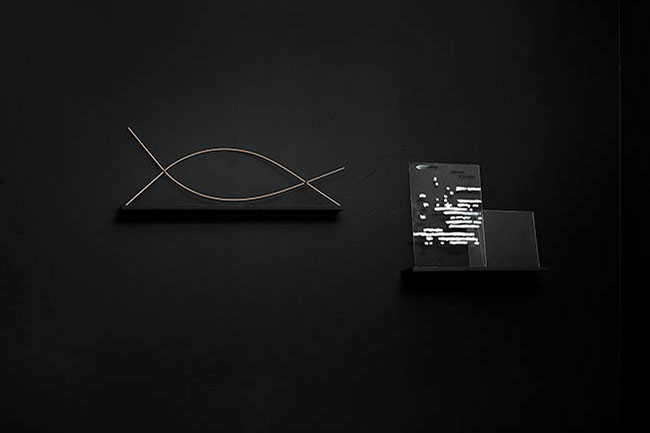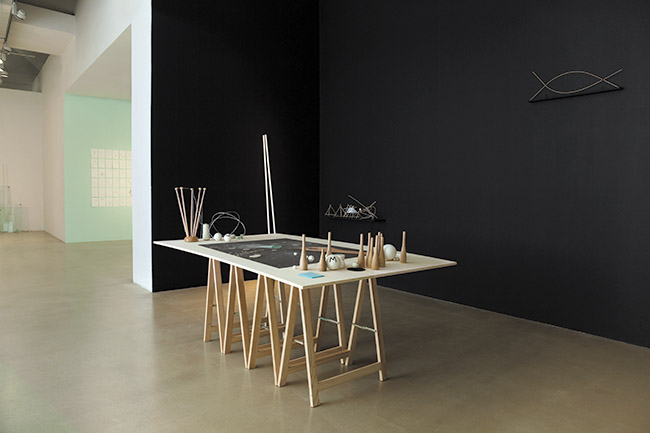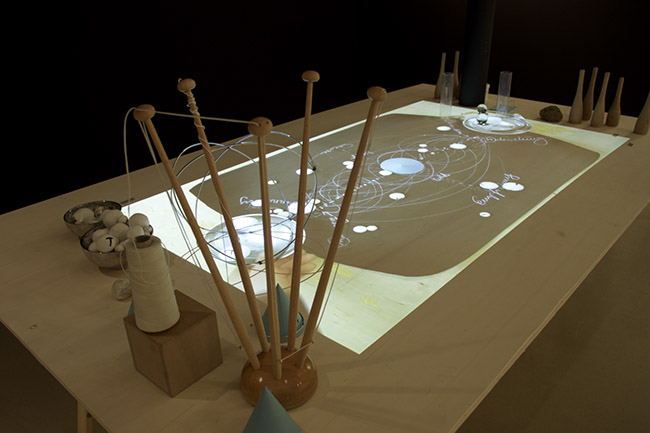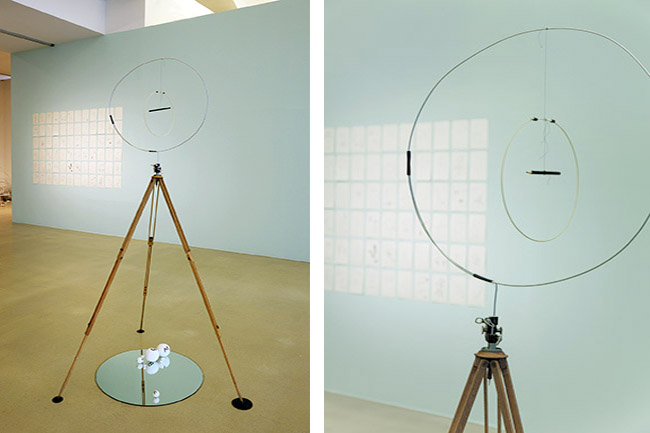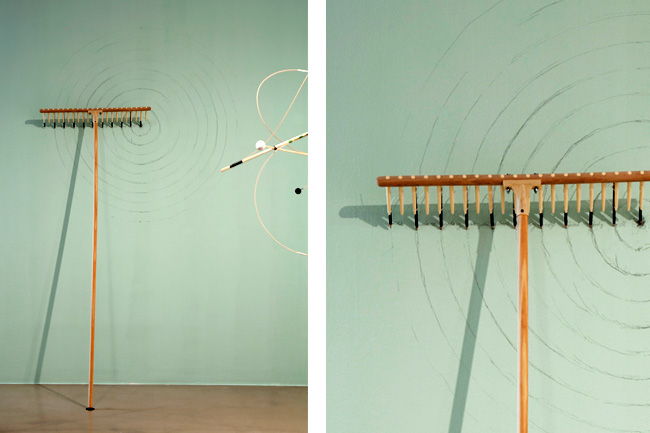When Thought becomes Matter and Matter turns into Thought
WHEN THOUGHT BECOMES MATTER AND MATTER TURNS INTO THOUGHT
In his comprehensive solo exhibition Nikolaus Gansterer carries out fundamental research in the field of creative working processes. The title of the exhibition in the Kunstraum Niederoesterreich is programmatic: When thought becomes matter and matter turns into thought. Thought processes temporarily assume form and material and become the starting points for new lines of thought. An independent cosmos of works emerges in which they repeatedly refer to one another.
In the gallery, in which various objects open up perspectives and the traces of the artist creating a narration, an area is dedicated to Translectures. One part of the room functions as a lab in which the artist works on site: here things are in the process of emerging, of becoming, the artist’s working process can be understood and grasped directly on the site of events, for example on the basis of trees of knowledge, bodies of theory and figures of thought. This “exhibition lab” creates exciting insights into essential questions of human perception and interpretation that tell of the subjective construction of reality.
With his many-layered work in the Kunstraum Niederoesterreich, Gansterer continues the transformation of thoughts into material into thoughts. Through the creation of reflexive spaces of perception that flow into one another, overlap with one another or merge with one another, he succeeds in creating a very specific language for these inner cognition processes.
Exhibtion: When Thought becomes Matter and Matter turns into Thought, Kunstraum Niederoesterreich, Vienna, Austria, June - July 2013
Publication: Nikolaus Gansterer, When Thought becomes Matter and Matter turns into Thought, Exhibition catalogue, published by Kunstraum Niederoesterreich, 70p. 65 illus., 48 in colour. Softcover,
With text by Christiane Krejs, Andreas Spiegl, Karin Harrasser, Emma Cocker, Graphic design: Simona Koch
ISBN: 978-3-9503500-2-9
Order via Kunstraum.net
Reviews:
– Nikolaus Gansterer, Vienna, Critics' Picks, Franz Thalmair, Artforum.com
– Im Kosmos der flüchtigen Gedanken, Stefan Weiss, Der Standard, 27.06. 2013
– Der Ausstellungsraum als Kunstkosmos, Christof Habres, Wiener Zeitung, 12.06.2013
– Denkfigurenlabor, Elvira M. Gross, K2-Centrope Magazin, 02/2013
– Den Sprüngen der Synapsen auf der Spur, Nicole Scheyerer, Falter #25/2013_S.27
– Vom Gedanken zur Materie, Verena Kienast, Morgen 3/2013
– Denken, Chaos, Wirklichkeit, Luise Wolf, The Gap, 27.06.2013
– Kunst im Labor: Geistesblitze in Diagrammform, Nicole Scheyerer, Falter #23/2013_S.34
– "When- thought becomes matter and matter turns into thought", TV clip on Sonntags-Matinee, ORF, 02.06.2013
"The Hypotenuse – The Scent of a Right Angle"
Text by Andreas Spiegl, (2013)
Published in the catalogue on the occasion of the solo exhibition by Nikolaus Gansterer “WHEN THOUGHT BECOMES MATTER AND MATTER TURNS INTO THOUGHT” at Kunstraum Niederoesterreich, in Vienna.
_______________>>>_Download text (English)
In a right-angled triangle the hypotenuse is the longest side, which is opposite the right angle. One could explain that the use of this term to describe a triangle goes back to Plato or to the Pythagoras theorem, which is also called the hypotenuse theorem. Ifaandbare the two legs of a triangle andcis the hypotenuse, then the equationa2+ b2= c2 applies. The sum of the areas of the squares of the two legs is equal to the area of the square of the hypotenuse.
One could say that this equation has established itself in cultural history. Alongside the mathematical law, however, one could also say that the term “hypotenuse” sounds wonderful purely phonetically: “hypotenuse” – as if one could thereby describe the melancholy of a promise, a beautiful flower that one gives to one’s beloved in order to express the indescribability of love, to give shape to the inexpressible, yes, colour + shape squared: “Oh, a hypotenuse! What a scent, the soft leaves” Then followed by the appropriate look and kiss, which only confirm that one has understood the “declaration” (Erklärung). The hypotenuse as a declaration of love with the scent of a shared future. Here it appears to be important that one pronounces the “-use” ending long: “hypotenuuusseee”,the “s” voiced and the “e” like a French “è”, as dark as the beauty of melancholy.
Now, on the other hand one could maintain that there is no flower called a hypotenuse, which hidden from the light grows into a declaration of love. In this sense, the declaration may indeed not correspond to any fact at the other end, but the declaration itself seems understandable. Just the sound of the hypotenuse – its phonetic scent – could give its name to a beautiful flower. A flower that only exists in the imagination, a flower that only lovers can see and smell.
This explains the conjunctive, the possibility. If the declaration aims for clarity, then it describes the reasons and grounds if you will: a landscape of causality. Why something looks the way it does seems to have a reason. The reasons for the reality do not always appear in the picture of reality, remain hidden, hide like the gentle hypotenuse. The explanation (Erklärung) seeks to trace the arc between the hidden reasons and reality, develop as it were in the gap between the two. Its task … no ... rather the desire that it follows consists in making the two ends of the arc, the reality and the reason for it, known to one another. Essentially it lives from the fact that the two do not know one another, that reality knows its reason only as an unknown quantity. And the reverse is true, that only one reason for reality can seldom be drawn on and cultivated. Often only the whole bunch seems sufficient for a reason, thus reasons that do not know one another and are only introduced to each other through the explanation: the right angle, the triangle, the legs, the hypotenuse, the lighting, Pythagoras, the poetry, the water, the colour, the scent and love.
The explanation itself, however, does not just develop between the reasons it describes and the reality it seeks to describe as understandable, but hides as a gap, as if it itself were not a quantity, as if it had no history of its own. As a simple in between it would only be of a secondary nature, always endangered by the correct reasons that contradict it, that dispute its existence. As a false explanation it is then forgotten and supplanted by the next correct explanation. It is unnecessary to mention the virulent cultural history of the various explanations, their history, which represents a pure history of displacement; their mythological history, which explains the world through myths, the history of science, which explains the world scientifically, the history of enlightenment, the dialectics of enlightenment, the return of the everyday myths, the history of research as a history of explanation and so on. In sum, a square of changes and rejections, of convictions, corrections and refutations. Hypotheses, antitheses, hypotenuses, “antitenuses” – small and always too strongly smelling flowers in order to underline the linear error, a “scientifically coloured forget-menot”. Flowers of doubt and mistrust. Critical flowers.
If one wishes to “explain” the works of Nikolaus Gansterer – finally but nevertheless too soon, temporarily – then as the possibility to take the explanation itself into the picture, to portray the explanation, to give it a face, to explain the explanation. Thus as an attempt not to clarify something, but to draw the explaining itself, the gap between the conception of reasons and the conception of reality, to trace and sketch out this gap. To define the drawing as something that follows its subject and at the same time runs ahead of it. The tool box of his aesthetics draws on the history of explanations, on the vocabulary of sketches, models, diagrams, experiments, hypotheses and corrections. The subject of his explanations is only one variable, changeable, perhaps accidental: the world, art, the modern – with and without post – biology, thinking and feeling, love, freedom, the identity of an alter ego, memory, revolution, the ear, the gaze and one single day, an odyssey, sometimes without Homer and Joyce. Millimetre paper, in order to be quite exact, a set of experiments to give shape to the history of its explaining. To raise the explanation and drafting or reasons itself to a subject of reflection. Learning to understand wanting to understand. As if there were a mechanism of understanding, a physics of explaining, an aesthetics of substantiation. What happens “WHEN THOUGHT BECOMES MATTER AND MATTER TURNS INTO THOUGHT” – the title of his exhibition. The reasons are as variable as the materials and media that are employed, and as the thoughts that trigger them. Perhaps it is also the thoughts that suggest and justify particular media and materials. If explaining itself moves to the centre of explaining, then the themes and reasons are just props, and themselves become materials and variables.
In the knowledge of the history of displacement that is inscribed in the history of explanations, change counts as a law. What appears to be explanation is essentially transient, has a half-life, the knowledge of limited duration. If one looks at his drawings, the fragile arrangements of balancing objects, the insistence on the momentary, the balance, the pausing, then at the same time one sees the process, what is processual in his work. An aesthetics of in between, which already sketches out both its ends of the before and after, the past and the future, the model of a temporality. As an explanation it lies in between, in an in-between time. As an explanation, it also keeps at a distance what it speaks of, what it explains. The model and the map, the mapping, trace their motif inasmuch as they abstract it, leave it in order to be something else. The drawing of something essentially also appears as a drawing for its own sake, as the drawing of a drawing. The model is also a model of itself, a suggestion of the materialisation of an explanation. Against the background of his three-dimensional installations, his stagings of space, the space itself appears as a model-like figure, as a possibility. As if one were to transform reality itself into the state of a model again, to bend it back into just a manifestation of an explanation – knowing that this ultimately remains hypothetical.
If reality presents itself as the product of changed and changeable explanations, then it itself appears only as a hypotheses, as a model and possibility of an understanding. Only the model-like is real, the distance to the unknown which one meanwhile attempts to explain. In this sense, the attempt at explanation also stands for the attempt to maintain a distance to what one is explaining. The scale of the model or of the drawing indicates the distance to the object that is traced and sketched out in it. A distance to the grounds, essentially a floating in space and time. And these coordinates of floating provide the model for a life that unfolds between the justifications and the conceptions of reality like the leaves of the hypotenuse, a scent opposite the right angle.
"Die Hypotenuse: Der Duft eines rechten Winkels"
Text: Andreas Spiegl
Publiziert anlässlich der Einzelausstellung von Nikolaus Gansterer
“WHEN THOUGHT BECOMES MATTER AND MATTER TURNS INTO THOUGHT“
im Kunstraum Niederoesterreich in Wien.
_______________>>>_Download text (German)
In einem rechtwinkeligen Dreieck bildet die „Hypotenuse“ die längste Seite des Dreiecks, die dem rechten Winkel gegenüberliegt. Man könnte nun erklären, dass die Verwendung dieses Begriffs für die Beschreibung eines Dreiecks auf Platon zurückgeht oder auf den „Satz des Pythagoras“, der auch als „Hypotenusensatz“ bezeichnet wird. Bilden die Seiten a und b die Katheten eines Dreiecks und c die Hypotenuse, dann gilt für diese die Gleichung: a2 + b2 = c2. Die Summe der Flächeninhalte der Quadrate aus den Katheten entspricht dem Flächeninhalt eines Quadrats der Hypotenuse.
Man könnte sagen, dass sich diese Erklärung kulturgeschichtlich durchgesetzt hat. Neben der mathematischen Erklärung könnte man aber auch behaupten, dass der Begriff der „Hypotenuse“ allein phonetisch wunderbar klingt: „Hypotenuse“ – als könnte man damit die Melancholie eines Versprechens beschreiben, eine schöne Blume, die man der Geliebten schenkt, um der Unbeschreiblichkeit der Liebe Ausdruck zu verleihen, dem Unaussprechlichen Form zu geben, ja Farbe + Gestalt zum Quadrat: „Oh, eine Hypotenuse! Was für ein Duft, die zarten Blätter!“ Dann folgen der entsprechende Blick und Kuss, die nur bestätigen, daß man die „Erklärung“ verstanden hat. Die Hypotenuse als Liebeserklärung mit dem Duft einer gemeinsamen Zukunft. Wichtig erscheint dabei, dass man die Endung „…use“ lang ausspricht: „Hypotenuuuusseee“, das „s“ stimmhaft und das „e“ wie das französische „è“, so dunkel wie das Schöne an der Melancholie.
Nun könnte man dagegen halten, dass es keine Blume gibt, die Hypotenuse heißt und im Verborgeneneiner Lichtung als Liebeserklärung heranwächst. In diesem Sinne entspricht der Erklärung zwar kein Sachverhalt am anderen Ende, aber die Erklärung selbst scheint nachvollziehbar. Allein der Klang der Hypotenuse – ihr phonetischer Duft – könnte für eine schöne Blume den Namen spenden. Eine Blume, die nur in der Vorstellung existiert, eine Blume, die nur Liebende sehen und riechen können.
Erklärt ist damit das Konjunktivische, die Möglichkeit. Wenn die Erklärung auf die Klärung zielt, dann zeichnet sie Begründungen und Gründe, wenn man so will: eine Landschaft der Kausalität. Warum etwas so und so erscheint, scheint Gründe zu haben. Die Gründe für die Realität scheinen im Bild der Realität nicht immer auf, halten sich im Verborgenen, verstecken sich wie die zarte Hypotenuse. Die Erklärung versucht den Bogen zwischen den verborgenen Gründen und der Realität nachzuzeichnen, entwickelt sich quasi im Zwischenraum von beiden. Ihre Aufgabe … nein … vielmehr das Begehren, dem sie folgt, besteht darin, die beiden Enden des Bogens, die Realität und die Gründe für diese, miteinander bekannt zu machen. Wesentlich lebt sie davon, dass die beiden einander nicht kennen, dass die Realität ihren Grund nur als unbekannte Größe kennt. Und umgekehrt gilt, dass selten lediglich ein Grund für die Realität als Begründung herangezogen und gezüchtet werden kann. Oft erscheint nur ein ganzer Strauß aus Gründen für eine Begründung hinreichend, mithin Gründe, die sich gegenseitig nicht kennen und erst durch die Erklärung einander vorgestellt werden: der rechte Winkel, das Dreieck, die Katheten, die Hypotenuse, die Lichtung, Pythagoras, die Poesie, das Wasser, die Farbe, der Duft und die Liebe.
Die Erklärung selbst entfaltet sich aber nicht nur zwischen den Gründen, die sie zeichnet, und der Realität, die sie als nachvollziehbare beschreiben will, sondern versteckt sich gerne als Zwischenraum, als wäre sie selbst keine Größe, als hätte sie selbst keine Geschichte. Als bloßes Dazwischen wäre sie nur von sekundärer Natur, immer gefährdet von den richtigen Gründen, die sie widerlegen, ihr die Existenz absprechen. Als falsche Erklärung verschwindet sie dann im Vergessen und wird von der nächsten richtigen Erklärung verdrängt.
Es erübrigt sich auf die virulente Kulturgeschichte der verschiedenen Erklärungen hinzuweisen, auf ihre Geschichte, die eine reine Verdrängungsgeschichte darstellt: auf ihre mythologische Geschichte, die Welt mit Mythen zu erklären, auf die Wissenschaftsgeschichte, die Welt wissenschaftlich zu erklären, auf die Geschichte der Aufklärung, auf die Dialektik der Aufklärung, auf die Wiederkehr der Mythen des Alltags, auf die Geschichte der Forschung als Erklärungsgeschichte usf. In Summe: ein Quadrat der Veränderungen und Verwerfungen, der Überzeugungen, Korrekturen und Widerlegungen. Hypothesen, Antithesen, Hypotenusen, „Antitenusen“ – kleine und immer zu stark riechende Blumen, um den geradlinigen Irrtum zu unterstreichen, ein „wissenschaftlich gefärbtes Vergiss-mein-nicht“. Blumen des Zweifels und Misstrauens. Kritische Blumen.
Wollte man nun die Arbeiten von Nikolaus Gansterer „erklären“ – endlich und doch zu früh, vorübergehend – dann als Möglichkeit, die Erklärung selbst ins Bild zu nehmen, die Erklärung zu porträtieren, ihr ein Gesicht zu geben, die Erklärung zu erklären. Mithin als Versuch, nicht etwas zu klären, sondern das Erklären selbst, den Zwischenraum zwischen der Vorstellung von Gründen und der Vorstellung von Realität, zu zeichnen, diesen Zwischenraum nachzuzeichnen und vorzuzeichnen. Die Zeichnung als etwas zu definieren, das seinem Gegenstand folgt und ihm zugleich vorauseilt. Das Instrumentarium seiner Ästhetik greift auf die Geschichte der Erklärungen zurück, auf das Vokabular von Skizzen, Modellen, Diagrammen, Versuchsanordnungen, Hypothesen und Korrekturen. Der Gegenstand seiner Erklärungen ist nur eine Variable, veränderbar, vielleicht zufällig: die Welt, die Kunst, die Moderne, mit und ohne Post, die Biologie, das Denken und Fühlen, die Liebe, die Freiheit, die Identität eines Alter Ego, das Gedächtnis, die Revolution, das Ohr, der Blick und ein einziger Tag, eine Odyssee, manchmal ohne Homer und Joyce. Millimeterpapier, um ganz exakt zu sein, eine Versuchsanordnung, der Geschichte des Erklären seine Form zu geben. Das Erklären und Entwerfen von Gründen selbst zum Gegenstand des Reflektierens zu erheben. Das Verstehen-Wollen verstehen zu lernen. Als gäbe es eine Mechanik des Verstehens, eine Physik des Erklärens, eine Ästhetik des Begründens. Was passiert, „WHEN THOUGHT BECOMES MATTER AND MATTER TURNS INTO THOUGHT“ – so der Titel seiner Ausstellung. Die Gründe sind so variabel wie die Materialien und Medien, die zum Einsatz kommen, und wie die Gedanken, die sie auslösen. Vielleicht sind es auch die Gedanken, die bestimmte Medien und Materialien nahelegen und begründen. Wenn sich das Erklären selbst ins Zentrum des Erklärens rückt, dann sind die Themen und Gründe nur Requisiten, werden selbst zu Materialien und Variablen.
Im Wissen um die Verdrängungsgeschichte, die der Geschichte der Erklärungen eingeschrieben ist, gilt die Veränderung als Gesetz. Was als Erklärung erscheint, ist wesentlich von vorübergehender Natur, folgt der Halbwertszeit, dem Wissen um die begrenzte Dauer. Betrachtet man seine Zeichnungen, die fragilen Anordnungen von balancierenden Objekten, das Insistieren aufs Augenblickliche, das Gleichgewicht, das Innehalten, dann sieht man zugleich den Prozess, das Prozessuale seiner Arbeit. Eine Ästhetik des Dazwischen, das seine beiden Enden des Davor und Danach, der Vergangenheit und Zukunft schon skizziert, das Modell einer Zeitlichkeit. Als Erklärung liegt sie dazwischen, in einer Zwischenzeit. Als Erklärung hält sie aber auch auf Distanz, wovon sie spricht, was sie erklärt. Das Modell und die Landkarte, das Mapping, folgen ihrem Motiv, indem sie es abstrahieren, es verlassen, um etwas anderes zu sein. Die Zeichnung von etwas erscheint wesentlich auch als Zeichnung um ihrer selbst willen, als Zeichnung einer Zeichnung. Das Modell ist auch Modell seiner selbst, ein Vorschlag der Materialisation einer Erklärung. Vor dem Hintergrund seiner raumgreifenden Installationen, seiner Inszenierungen von Raum, erscheint der Raum selbst als modellhafte Figur, als Möglichkeit. Als würde man die Realität selbst noch einmal in den Zustand eines Modells verwandeln, sie zurückbiegen in die bloße Manifestation einer Erklärung – im Wissen, daß diese letztlich hypothetisch bleibt.
Wenn sich die Realität als Produkt veränderter und veränderbarer Erklärungen darstellt, dann erscheint sie selbst nur als Hypothese, als Modell und Möglichkeit eines Verstehens. Real allein ist das Modellhafte, die Distanz zum Unbekannten, das man sich zwischenzeitlich zu erklären versucht. In diesem Sinne steht der Versuch des Erklärens auch für den Versuch auf Distanz zu halten, was man sich gerade erklärt. Der Maßstab des Modells oder der Zeichnung bezeichnet die Distanz zum Gegenstand, der darin nachgezeichnet und vorgezeichnet wird. Eine Distanz zu den Gründen, wesentlich ein Schweben in Raum und Zeit. Und diese Koordinaten des Schwebens liefern das Modell für ein Leben, das sich zwischen den Begründungen und den Realitäts-vorstellungen entfaltet wie die Blätter der Hypotenuse, ein Duften gegenüber dem rechten Winkel.
